Flagler Street, the historical backbone of Downtown Miami, is undergoing a significant transformation to reclaim its status as a vibrant, pedestrian-friendly, and economically thriving urban core. This ambitious Flagler Street Beautification Project, a collaborative effort between the City of Miami’s Office of Capital Improvements, the Flagler District Business Improvement District (BID), and the Miami Downtown Development Authority (Miami DDA), aims to convert this iconic street into a festival-style boulevard, enhancing its functionality and appeal for residents, businesses, and visitors alike.
Project Overview: Crafting a Festival Street Experience on Flagler Street
The core objective of the Flagler Street project is to create a dynamic and inviting space stretching from Biscayne Boulevard to NW 1st Avenue. This will be achieved by raising the street level to meet the sidewalks, eliminating curbs to create a seamless pedestrian and vehicular environment, and incorporating elegant pavers within the travel lanes. This curbless street design is central to the vision of a revitalized Flagler Street.
Key enhancements of the Flagler Street Beautification Project include:
- Elevated Pedestrian Experience: Wider sidewalks are designed to encourage leisurely strolls and window shopping, complemented by generous shade trees, inviting outdoor café spaces, enhanced LED lighting for safety and ambiance, clear signage, public art installations, and comfortable seating areas. These elements are crucial in making Flagler Street a desirable destination.
- Versatile Public Space: The reimagined Flagler Street will have the flexibility to close off individual blocks to vehicular traffic, transforming them into vibrant hubs for community gatherings, festivals, farmers’ markets, art fairs, and family-friendly evening events throughout the year. This adaptability is key to fostering a lively street culture.
- Prioritizing Pedestrians and Valet Services: To maximize pedestrian space, on-street parking will be minimized. Valet parking services will be readily available, offering convenient car retrieval anywhere along the Flagler Street corridor. This focus on pedestrian access and convenient parking solutions aims to improve the overall visitor experience.
- Upgraded Infrastructure: The project includes critical upgrades to the existing drainage systems to mitigate flooding issues, ensuring a more resilient and comfortable environment.
- Future-Proof Utilities: Installation of new and upgraded utilities – power, gas, and fiber optics – is a forward-thinking element, designed to support future vertical development along Flagler Street and prevent disruptive street repairs post-completion.
- Economic and Community Benefits: By creating a safer and more attractive shared space, the Flagler Street project intends to boost patronage for existing businesses, attract new ventures, stimulate economic growth in the area, and firmly re-establish Flagler Street as Downtown Miami’s premier cultural and commercial destination.
Construction Phases: Transforming Flagler Street Block by Block
To manage the extensive construction work while minimizing disruption, the Flagler Street Beautification Project is strategically divided into five sections. This phased approach allows for concentrated construction activity while maintaining access and movement along the street.
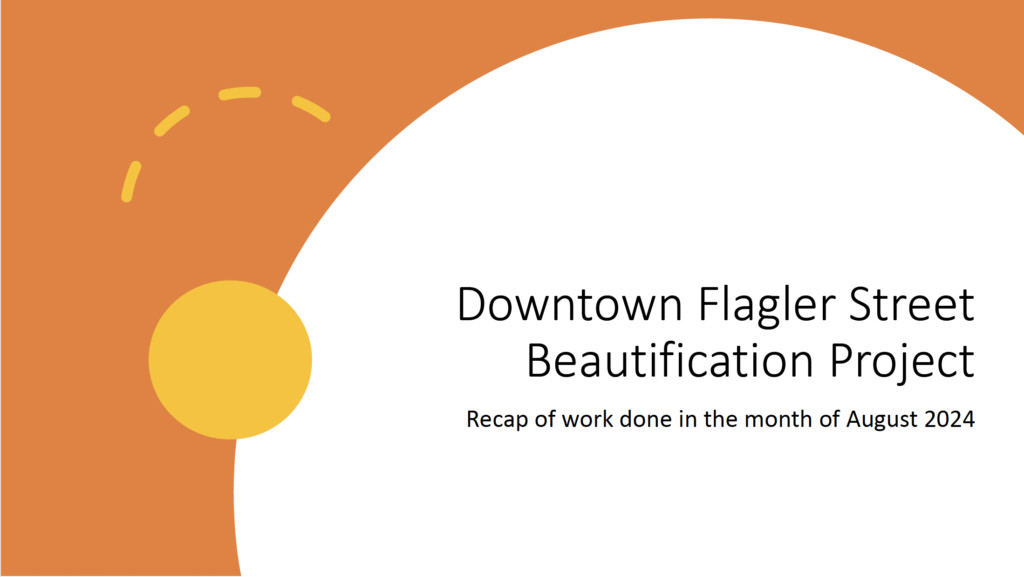
Image showcasing recent construction progress on the Flagler Street Beautification Project, highlighting the transformation underway.
Each phase is estimated to take approximately twelve months, with the overall project duration influenced by factors such as weather conditions, unforeseen underground utilities, and coordination with utility providers like Florida Power & Light (FP&L). Construction is progressing from east to west, beginning at Biscayne Boulevard and moving towards NW 1st Avenue. The sections are defined as follows:
- Section A: Biscayne Boulevard to SE/NE 3rd Avenue
- Section B: SE/NE 3rd Avenue to SE/NE 2nd Avenue
- Section C: SE/NE 2nd Avenue to SE/NE 1st Avenue
- Section D: SE/NE 1st Avenue to S/N Miami Avenue
- Section E: S/N Miami Avenue to SW/NW 1st Avenue
Detailed Maintenance of Traffic (MOT) detour plans are developed for each section as construction commences, ensuring that traffic flow is managed effectively throughout the project. For the latest updates and to see previous construction progress, you can click here.
Navigating Construction: Maintenance of Traffic (MOT) on Flagler Street
Currently, Sections C & D, spanning from E 2nd Avenue to Miami Avenue, are under active construction.
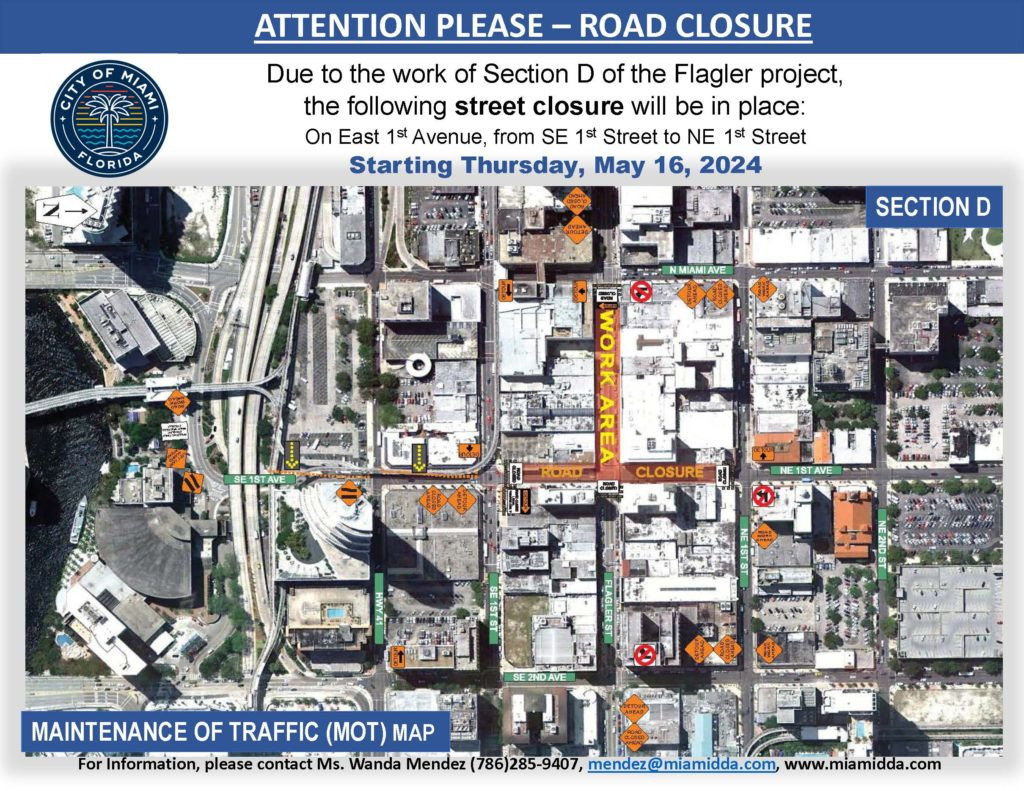
Image illustrating the Maintenance of Traffic (MOT) plan for NE 1st Avenue, part of the Flagler Street construction zone, ensuring pedestrian and vehicular safety.
For detailed information on current and past traffic alerts related to the Flagler Street project, please click here.
Parking and Access During Construction on Flagler Street
While vehicular traffic is restricted within active construction zones, pedestrian access to businesses along Flagler Street remains open during normal business hours. Valet parking services and alternative parking solutions are being implemented to support businesses and visitors during the construction period.
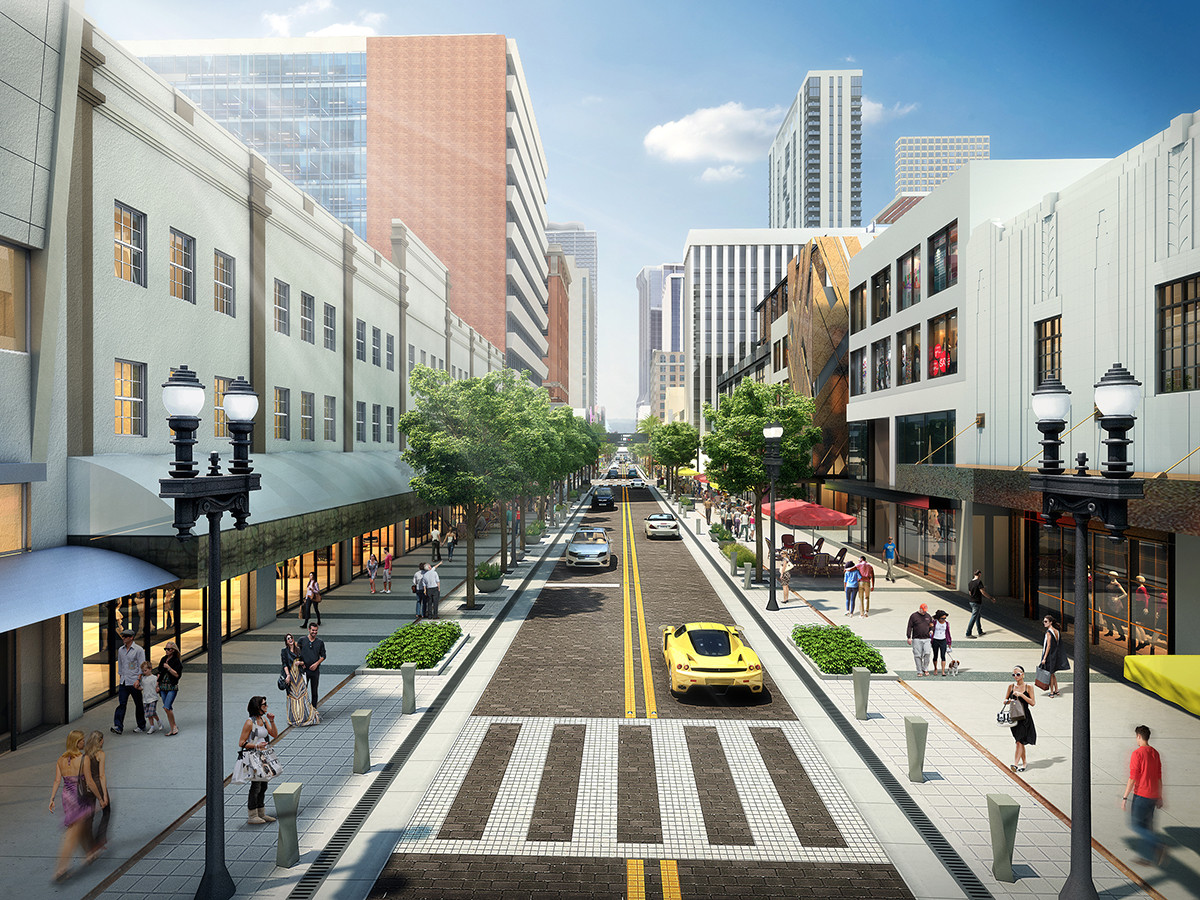
Conceptual image depicting the future vision of Flagler Street with valet parking and a pedestrian-friendly environment, enhancing accessibility and convenience.
Specific parking information for each section is being communicated through project updates and signage to minimize inconvenience. For example, details on parking arrangements for Section D have been made available to the public.
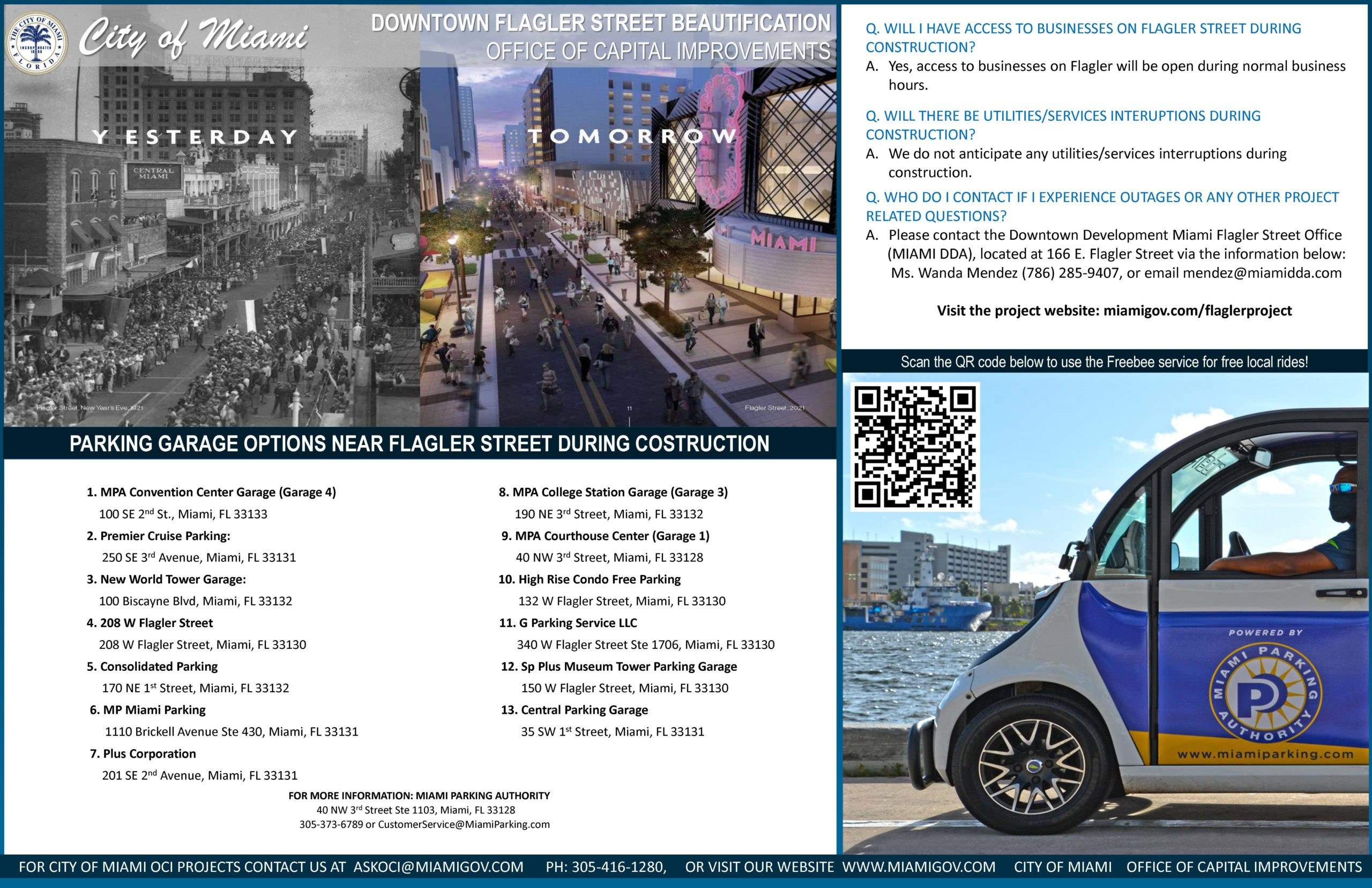
Informational poster detailing parking arrangements and access points for Section D of the Flagler Street Beautification Project, ensuring clear guidance for visitors and businesses.
Frequently Asked Questions about the Flagler Street Project
To address common queries and concerns, the Miami DDA has compiled a list of Frequently Asked Questions (FAQs) regarding the Flagler Street Beautification Project:
Q: When did construction start for the Flagler Beautification Project?
A: Construction commenced in the first week of May 2021.
Q: What is the estimated duration of the project?
A: The project is anticipated to take between 40 to 50 months (3-4 years). This timeline is subject to adjustments due to weather, unforeseen underground utilities, coordination with FP&L, and other unexpected circumstances.
Q: Will Flagler Street be completely closed during construction?
A: No, closures will be limited to vehicular traffic within the active work zone of each section.
Q: Will pedestrian access to businesses on Flagler Street be maintained during construction?
A: Yes, businesses will remain accessible to pedestrians during normal business hours throughout the construction period.
Q: Will utility services be interrupted during construction?
A: Utility services will remain fully operational throughout the construction phases. Advance notice will be provided daily if construction work is expected to impact utilities in specific areas.
Envisioning the Future: Design Concepts for Flagler Street
The Flagler Street revitalization is guided by thoughtful design concepts that blend historical context with modern urban needs.
Original Design Concept: Honoring Miami’s Railroad Heritage
The initial design concept, developed by Curtis & Rogers Design Studio, drew inspiration from Miami’s rich history, particularly the pivotal role of Henry Flagler’s railroad in the city’s development.
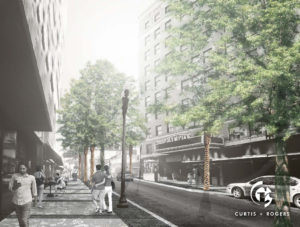
Conceptual sketch from Curtis + Rogers Design Studio illustrating the original design vision for Flagler Street, emphasizing pedestrian-friendly enhancements and historical references.
This concept aimed to create a pedestrian-friendly retail environment with widened sidewalks and ample shade trees. The sidewalk design was envisioned to echo the rhythmic pattern of railroad ties, a nod to Flagler’s legacy and the street’s historical significance as the trolley line route to the County Courthouse and a major train depot. Materials like aggregate concrete were chosen to reflect the pioneering spirit of Miami’s founders, while embedded steel railroad ties were intended as tactile historical markers within the sidewalk itself.
Innovative Silva Cells were incorporated into the design to support the growth of 100 Live Oak shade trees, providing stormwater management benefits. Date palms were planned for intersections to enhance visibility, and energy-efficient LED lighting and railroad crossing gates for event blockades were also part of the original vision.
New Design Concept: Embracing a Curbless Festival Street
Building upon the original framework, a new design concept emerged through a collaboration between Curtis & Rogers Design Studio, Zyscovich Architects, and BCC Engineering. This revised concept envisions Flagler Street as a curbless, festival street, inspired by successful models like Miracle Mile in Coral Gables and Rosemary Avenue in Downtown West Palm Beach.
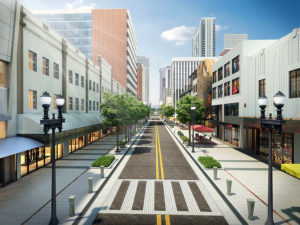
Image portraying the envisioned curbless design of the revitalized Flagler Street, emphasizing a seamless transition between pedestrian and vehicular spaces for a festival-like atmosphere.
The new design features concrete pavers for the roadway and utilizes a combination of bollards, benches, trees, landscape planters, and trash receptacles to define pedestrian zones and deter vehicles from sidewalks. The continued upgrade of utilities remains a key component of this evolved design, preparing Flagler Street for future development.
For a glimpse into the planned street furnishings and aesthetic elements, you can explore the “Coming Soon…” furnishing palette.
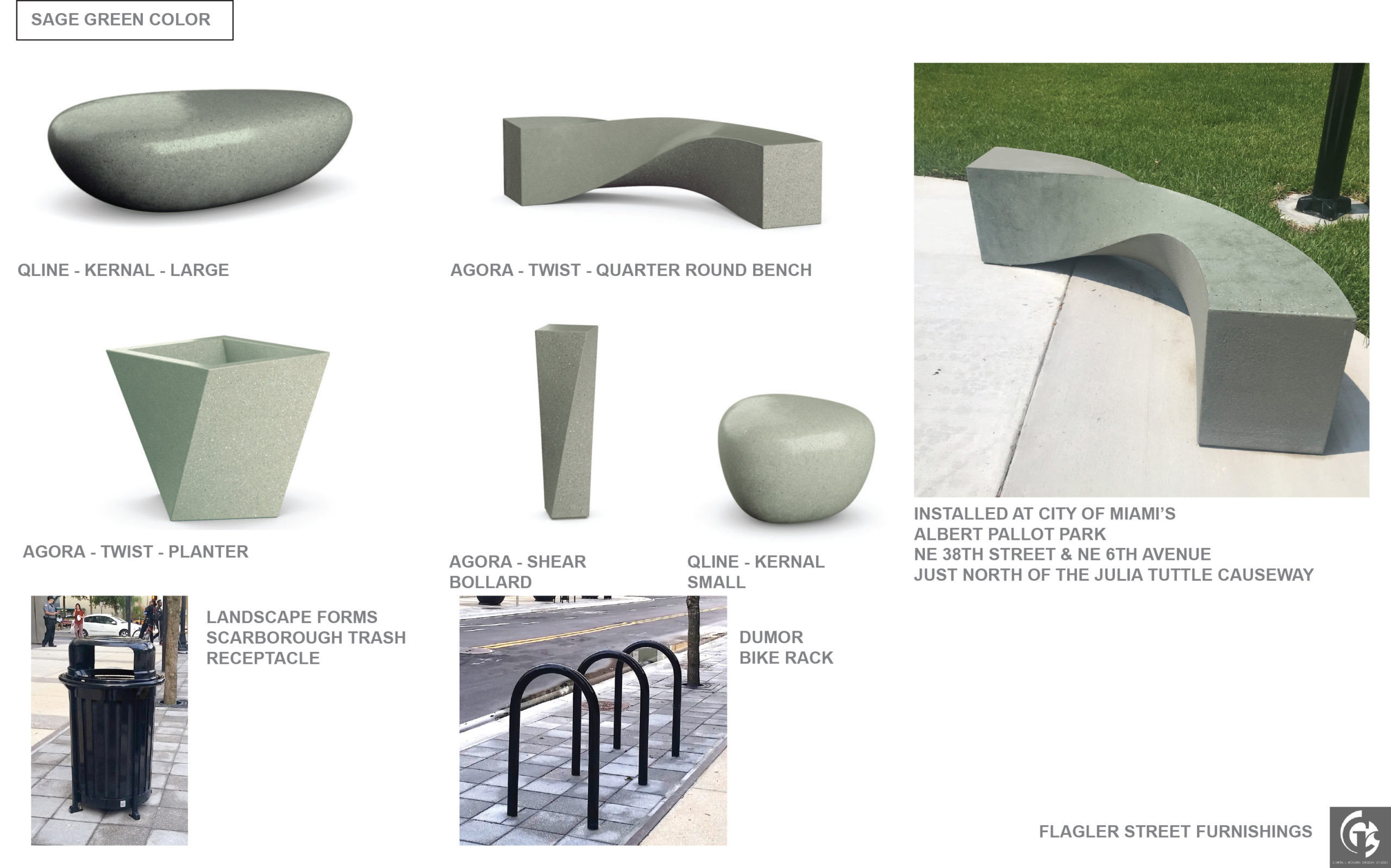
Image showcasing the planned furnishings palette for the revitalized Flagler Street, including seating, lighting, and landscaping elements that will enhance the streetscape.
Community Engagement: Virtual Meeting and Project Feedback
The City of Miami and project partners prioritized community engagement throughout the Flagler Street Beautification Project. A virtual Community Meeting was held on April 21, 2021, to share design plans, construction schedules, traffic management strategies, and address stakeholder concerns.
For those interested in reviewing the presentation from this meeting, it is available here.
Share Your Thoughts: Project Questions and Comments
The Miami DDA encourages ongoing community feedback. For any questions or comments regarding the Flagler Street Beautification Project, please reach out via email.

Icon encouraging public feedback and questions regarding the Flagler Street Beautification Project, promoting community involvement and transparency.
Click ‘Contact Comments’ to submit your inquiries to [email protected] Contact Comments .
A Walk Through History: The Legacy of Flagler Street
Flagler Street’s story is deeply intertwined with the history of Miami itself. In the late 1800s, industrialist Henry Flagler’s first Miami hotel on what was then 12th Street marked the beginning of Flagler Street as Miami’s central thoroughfare.

Historical image of Flagler Street in the 1880s, showcasing its early days as Miami’s main street and the impact of Henry Flagler’s hotel.
Image courtesy of Miami-History.com
Beyond the hotel, the street quickly became the heart of the burgeoning city, hosting the original courthouse, diverse shops, and the first Burdines department store. In 1921, 12th Street was officially renamed Flagler Street, establishing it as the North-South dividing line for Miami’s grid street system. The 1920s solidified Flagler Street’s position as Miami’s vibrant core, fueled by a land boom that doubled the city’s population and spurred the development of iconic nearby communities.

Historical photograph of Flagler Street in the 1910s-1920s, capturing the bustling atmosphere of its heyday as Miami’s central commercial and social hub.
Image courtesy of Miami-History.com
Despite the challenges of the Great Depression in the 1930s, Flagler Street continued to flourish, buoyed by Miami’s appeal as a warm-weather destination. The city’s first skyscraper, the Historic Alfred I. DuPont Building, was erected on Flagler Street in 1938, and the burgeoning aviation industry further connected Miami to the world.
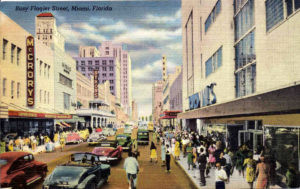
Image from the 1940s depicting Flagler Street’s continued prominence, showcasing its role as a thriving commercial and retail center even during challenging economic times.
Image courtesy of Miami-History.com
The post-World War II era marked Flagler Street’s golden age. From the 1950s through the late 1960s, it was Miami’s most prestigious business address and stylish retail destination. Stores stayed open late, and entertainment venues like the 1500-seat Olympia Theater thrived, drawing crowds to the street.
The rise of suburban malls in the 1970s led to a decline in downtown retail districts across America, including Flagler Street. However, an influx of Cuban refugees revitalized the area, opening and supporting businesses along Flagler Street. Later, the vision of individuals like Tony Alonso, a former Miami DDA board member, spurred efforts to restore Flagler Street to its former glory. This led to the formation of the Flagler Street Task Force in 2011, uniting stakeholders to drive revitalization.
Property owners demonstrated their commitment by agreeing to self-taxation in 2014 to fund the revitalization project. Subsequent funding approvals from Miami-Dade County and the City of Miami brought the project to fruition. The Flagler Street Beautification Project builds upon the successful redevelopment models of Lincoln Road, Ocean Drive, and Sunset Drive, aiming to create a pedestrian-friendly, landscaped streetscape that reclaims Flagler Street’s legacy as Miami’s dynamic urban core.
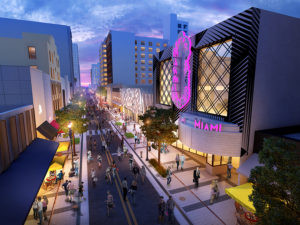
Nighttime image of Flagler Street, representing the envisioned future of a vibrant and pedestrian-friendly urban space that honors its historical significance.
Image courtesy of Mana Miami
This project is not just a restoration; it is a transformative step towards creating a dynamic downtown Miami that meets the expectations of its residents, workforce, and visitors, ensuring Flagler Street remains a vital part of the city’s identity for generations to come.


